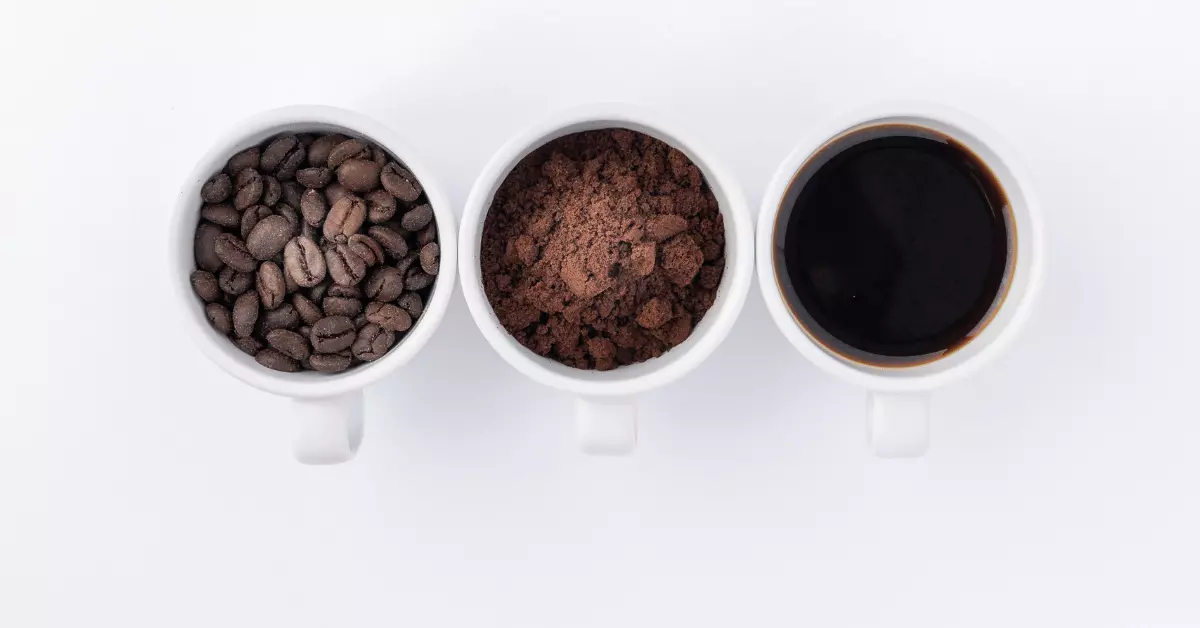
All you have to do is put them somewhere still, then pressure hard with something tough until they turn into coffee grounds. You can do it through mortar & pestle, rolling pin, or through hammer and towel. However, the most suitable and effective way is to put in a blender machine and grind your beans.
I found myself in a situation where I was looking for my grinder, and I couldn’t find it. After wasting 10 minutes of my time, I realized I had given the grinder to my mother the previous week. I was angry at myself for forgetting it and making my kitchen all messy.
However, I didn’t have enough time or energy to go to my mom’s and bring my grinder back. So I had to find another way to brew coffee. So, I kept asking myself how to brew coffee beans without a grinder. That is when I found the magic formula to grind coffee beans without a grinder.
But my journey didn’t end with crushed beans. I had to unlock the brewing secrets that pair perfectly with each grind, ensuring deliciousness from the ground beans. Whether it’s the coarse charm of a French press or the smooth seduction of cold brew, I will have you brewing like a pro in no time.
5 Creative Ways to Grind Your Coffee Beans into Coffee Grounds
You don’t have a grinder to grind coffee? No worries. Even though a coffee grinder is a barista’s best friend, it is not the only friend that can grind coffee. From my experience and research, I found the best ways to grind coffee without a grinder.
Fun fact: In Southeast Asia people prefer manually grounded beans, they believe it is more flavourful.
The Ancient Mortar and Pestle
Here’s a step-by-step guide to grind coffee beans like an ancient master using a mortar and pestle:
In ancient Greece, Asia, and many parts of the world people used to grind coffee beans through this process. It is one of the most popular and common ways to grind coffee beans. besides, in this system, you can also control the ground level too.
Gather Your Tools:
Mortar: A bowl-shaped vessel for crushing, often made of stone or wood.
Pestle: A club-shaped tool used to grind and crush ingredients within the mortar.
Start the Grind
- Start with placing the coffee beans into the mortar(the cup-shaped vessel), and fill in the mortar with ¼ th of its full capacity.
- Use a firm, downward pressure with the pestle into the mortar. Start to swirl the pestle to create coffee grounds
- First, the beans will be cracked, and trust me the sound of the cracking is satisfying. Then keep swirling the pestle to make finer grounds. Apply medium consistent pressure to make finer grounds.
- For coarser grounds use light pressure, and do not grind for too long. However, if you want a finer grind you have to keep grinding, applying more pressure until the beans are completely grounded.
Tips for Success
- Warm the beans: Gently warm the beans before putting in the mortar, it will help grinding a lot easier.
- Rotate the beans: while grinding, rotate the beans up and down inside the mortar using the pestle. This will help you to create a consistent finer ground.
- Listen to the sound: as you grind, the sound will change from cracking to a duller sound. This will help you understand the level of power needed
- Clean well: wash the mortar and pestle thoroughly after each use to avoid any residue.
[joomdev-wpc-pros-cons disable_title=”yes” wpc_style=”wppc-view2″ title_tag=”H3″ title=”Title Here” pros_title=”Pros” cons_title=”Cons” button_text=”Get it now” disable_button=”yes” button_link=”” button_link_target=”_SELF” button_rel_attr=”dofollow” verdict_text=””][joomdev-wpc-pros]
- You can achieve high precision through this system of grinding, and also maintain the level of grind.
- Grinding beans just before the brewing can achieve maximum aroma and freshness
[/joomdev-wpc-pros][joomdev-wpc-cons]
- This mortar & pestle takes away a lot of your time, and it is hard to do. It requires muscle power to keep grinding.
[/joomdev-wpc-cons][/joomdev-wpc-pros-cons]
Rolling Pin Power: Become a Roller
Here’s a step-by-step guide to channeling your inner baker and crushing coffee beans with a rolling pin:
Gather Your Tools
- Rolling Pin: A cylindrical tool, often used for flattening dough, now moonlighting as a bean-crushing machine.
- Sturdy Bag: A resealable bag like a Ziploc or a thick freezer bag to contain the beans and prevent mess.
Bean Bag
- Place your desired amount of coffee beans into a plastic bag, better if the bag is transparent.
- Seal the bag tightly, and ensure that there is no way for any bean to get out of the bag.
- Place the sealed bag on a flat, sturdy surface. A cutting board or just any flat surface works well.
- Hold the rolling pin firmly and apply pressure as you roll back and forth over the bag.
- Grind the beans with each roll, listening for the satisfying crackle as they break down.
Check and Adjust
- Pause after a few rolls to examine the grind size.
- For a finer grind, continue rolling until the beans resemble coarse sand.
- Customize the grind by adjusting the number of rolls and the pressure applied.
- Simple idea, you want finer grind? Keep rolling and putting pressure on the bag of beans.
[joomdev-wpc-pros-cons disable_title=”yes” wpc_style=”wppc-view2″ title_tag=”H3″ title=”Title Here” pros_title=”Pros” cons_title=”Cons” button_text=”Get it now” disable_button=”yes” button_link=”” button_link_target=”_SELF” button_rel_attr=”dofollow” verdict_text=””][joomdev-wpc-pros]
- Rolling pin grinding also gives you complete control over the beans. So you can control the level of grind.
[/joomdev-wpc-pros][joomdev-wpc-cons]
- It takes time & energy to continue this method.
[/joomdev-wpc-cons][/joomdev-wpc-pros-cons]
Bonus Tip: Stuck with clumps? Add a spoonful of sugar or rice before rolling. Trust us, your taste buds will thank you
The Hammer and Towel Method
- Wrap your beans in a plastic bag, and seal it properly so that the beans cannot get out of it at any cost. Put the beans inside the bag, and seal the bag.
- Choose a flat-headed hammer and start to softly hit the bag of beans. Do not hit the beans directly too hard, as it will create uneven grounds. Instead, put a constant medium pressure to create finer grounds.
- As you hammer, the sound will shift from a dull shot to a more pronounced cracking. This indicates progress, so stop and check the grind size to avoid crushing the beans.
Safety Matters: Wear eye protection and be mindful of your surroundings. Remember, it is a hammer you are working with.
The Blender Method: Fastest Method

Now here comes the fastest way among all the methods. The blender is a wonder of modern science when it comes to grinding anything. You just have to know how to use the grinder.
Blending with Brains:
- Choose a blender with a strong motor that is at least 700+ watts and has sharp blades in it. This will help grind the beans without putting much pressure on the machine itself.
- Go with high-quality beans, recently roasted for the best flavor. Measure 1/4th or 1/2th of a cup depending on the size of your pot.
- Start the blender with short pulses (not more than 2 seconds). This is for the beans to crack in an even way. Do not overdo the grind at the first pulse.
- As the beans become smaller increase the duration of pulse to 3-4 seconds. Slowly and gradually the beans will turn into a finer ground, in smaller chunks.
Tips for best performance
- 5-7 pulses of 2-3 seconds each will give you a coarse grind.
- 8-20 pulses of 2-3 seconds each will give you a sea salt type of grind
- 12-15 pulses of 2-3 seconds each will give you a powdery touch.
- Takes breaks between pulses to prevent the blender from overheating
Bonus Tip: Feeling clumsy? Don’t worry, practice makes perfect! And remember, it’s always easier to go from coarse to fine than the other way around.
Ice tray Crush
Tools needed Ice tray: Any standard plastic ice tray will work
Crushing Tool:
- Rolling pin
- Hammer
- Heavy spoon
Preparing the beans: Measure the beans and put the desired amount of coffee beans on the ice tray. Usually, 1-2 tablespoons per cup is a good amount. Also check if there is any extra dust, if there is remove that.
Process:
- Gold the ice tray firmly with your left hand
- Use your crushing tool to apply pressure to the beans, smash them into the grounds
- Adjust the pressure if you think you are getting to your desired level of ground. Use more pressure for finer grounds
- Transfer the coffee ground into a container
One thing that you need to remember is that in this method the coffee does not reach a powdery ground. It just breaks into really small pieces but doesn’t turn into powder-type ground. One hack is to break the coffee beans in this method, then crush them with the mortar & pestle.
Benefits of Grinding Beans without a Grinder
Freshness increases aroma: If you grind your beans manually it is most likely you are going to use them right then. It is said that freshly ground beans increase the flavor and aroma by 20%-50%. So, there you go, have a more intensified cup.
Control over the grind size: when in a grinder, most times you just put in the coffee beans. The grinder grinds them all and makes them powdery type. In the manual method, you can actually control it, you can have it however you want.
Budget-friendly: well, a grinder costs some bucks and also doesn’t go well for a long time. So, spending on a grinder every year may not seem like a very good solution. In that case, you can just grind manually without a grinder. Save some bucks.
Conclusion
In search of how to brew coffee beans without a grinder, you find out how to grind coffee beans even if you don’t have a grinder. There are many methods through which you can do this task. However, as you now know all the secrets of coffee bean grinding, what are you planning to do? Let us know in the comment section. If you want to know more about coffee beans, more about recommendations on coffee beans, etc, then definitely follow the coffee blog mart.

I am Mojoon, a certified and award-winning barista by choice, with 7 years of experience in the field. I have served and trained coffee shop baristas worldwide. I worked at Krispy Kreme for an extended period, and now I aim to help regular people brew coffee like me. I pursue this job with my passion for writing and also provide one-on-one coaching for newly minted baristas.